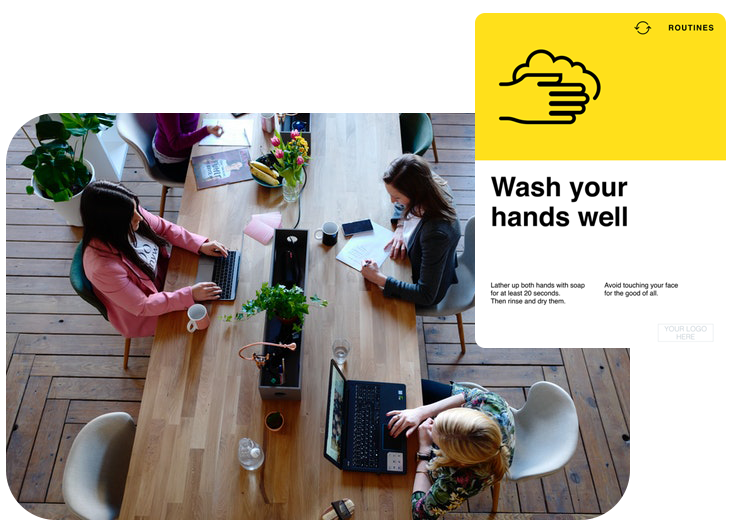Is it time to start thinking about building a Return to Office Plan for your organization?
It seems almost too good to be true, but after a year and a half of lockdowns, enforced social distancing, uncertainty, pain, and strife, we are seeing some encouraging signs of progress in beating back COVID-19. Cases are dropping as vaccination rates rise, and many countries are even putting together phased reopening plans, including plans around returning to office life. It won’t be long before we’re seeing the emergence of a “new normal”, whatever that may look like.
However, returning to the office is also seen as a bit of a hot-button issue right now. When workplaces closed and employees were told to work from home for the foreseeable future, a massive shift occurred; organizations adopted new ways of working that made it easier, and more effective for employees to work remotely.
This meant that the jobs that organizations had said needed to be done in-person, were now being done from kitchen tables, spare bedrooms, home offices, patios, cottages, and other unlikely places. Employees doing those jobs proved that they could be done remote, and this has led to push-back from those employees, who, when the pandemic is over, aren’t willing to go back to the office full-time. In fact, Harvard Business School’s recent study shows that a whopping 81% of workers either don’t want to go back to the office, or would prefer a hybrid solution going forward.
So, the question is, how do you build an efficient and effective return to office plan that both management and employees can be happy with? How can you make sure that you’re taking care of your employees’ physical and mental health while returning to the office?
This blog aims to answer those questions with our top 3 tips on how you can build a return to office plan.
Return to Office Plan!
Tip 1: Consider Your Return to Office Setup
The first thing to think about in your return to office plan is what type of setup you’re going to follow. Will you require a full return to office for all your workers? Are you open to hybrid remote/in-person solutions that allow for flexibility for days in and out of the office? Perhaps, since everyone’s been working remote effectively and efficiently since the start of the pandemic, you’ve decided that fully remote is your new “normal”.
It’s important to consider pros and cons of each set-up before making your decision. For instance, consider the amount of space your current office has. With social distancing around to stay for the foreseeable future, a full return to office of all employees may not be feasible for your current footprint. Do you have enough space for every employee to keep 6 feet apart?

Employee health and safety is another key consideration when determining what set-up, you may choose. Your organization will have to comply with new policies and regulations that have resulted from the pandemic, whether that’s following protocols for deep cleaning and/or sanitizing workstations, or changing the layout of your workspace to accommodate social distancing, or reducing how many people are allowed in your office at any given time. Knowing your local, provincial/state, or federal regulations can help you determine your return to office setup.
Once you’ve taken into account all factors, and made your decision on what your return to office setup is going to look like, then it’s time to get planning!
Tip 2: Understand Why You Need a Return to Office Plan
If you’ve decided that you’re going to bring your employees back to the office on a permanent or hybrid basis, it’s time to start working on your Return to Office Plan. But before you do, it's important to know why you're doing so.
Why do you need a Return to Office Plan?
There are a lot of moving parts to reopening your offices. Unlike what happened at the beginning of COVID-19 when we sent everyone home and gave them the tools to work remotely, we can’t just “flip a switch” and put everything back to the way it was before the pandemic.
A solid Return to Office Plan looks at everything – workplace health and safety, employee accountability and productivity, workforce discrimination, ensuring that information is accessible, employee and management expectations, addressing burn-out and other mental health concerns, and more. Without this in-depth look into all these “moving parts” of your business, your organization could face decreased productivity at the least, a significant rise in employee turnover, or, worst case, a rise in employee illness claims, both physical and mental.
Tip 3: Communicate, Communicate, Communicate!
We can’t stress this one enough. Once you’ve laid out your Return to Office Plan, clear communication to all staff can help everyone in the organization to manage their expectations and can lead to a peaceful and successful transition back to office life – whether full-time, or hybrid.
A return to office plan, when communicated properly, ensures that everyone in your organization – from frontline worker to CEO – is aware of what’s happening, what’s changing, how it impacts them, and what’s expected of them.

This is where having a communications platform, like Workplace from Facebook, becomes an asset – with a communications platform that is easily accessible to everyone, you can make sure that everyone not only has access to important documentation via file sharing and document sharing, but you can also use Workplace to make announcements, track who in the organization has viewed or read those announcements, take the temperature of employees with polls and bot-led wellness checks, provide go-live opportunities for C-levels to address FAQs, and much more.
Building a Return to Office Plan Takes Time, So Start Now!
Your Return to Office Plan will take time to develop, so it’s important to start now. And, whatever setup you choose to embrace for your “new normal” – full return to office, hybrid approach, or a fully remote model – it’s important to ensure that your employees are aware of what’s happening, and, whenever possible, allowed to provide feedback as these plans are being developed. And remember, the most effective leaders re-visit and build upon an often-overlooked skill: asking good questions.
Use Workplace to Communicate your Return to Office Plan!
In any situation that calls for change, communication is the most important thing. If your organization is already using Workplace and you want more information on how you can use it to roll out your Return to Office Plan, and provide your employees with opportunities to give feedback and support, LineZero is here to help! We’ll be happy to chat with you and help you create a strategy around using Workplace to enhance your communications throughout the transition to your “new normal”.
Not Using Workplace Yet?
If you’re not yet familiar with the benefits of Workplace from Facebook, let’s jump on a call for a brainstorming session! We’ll not only help understand how Workplace can help you to communicate the changes that will be coming to your organization with your new Return to Office Plan, but we’ll also show you a visual blueprint of how your existing technologies and Workplace from Facebook can integrate to form a seamless experience. Our unique experience allows us to help you close the gap between your business goals and objectives and your technology capabilities – give us a shout today.
June 08, 2021




Comments